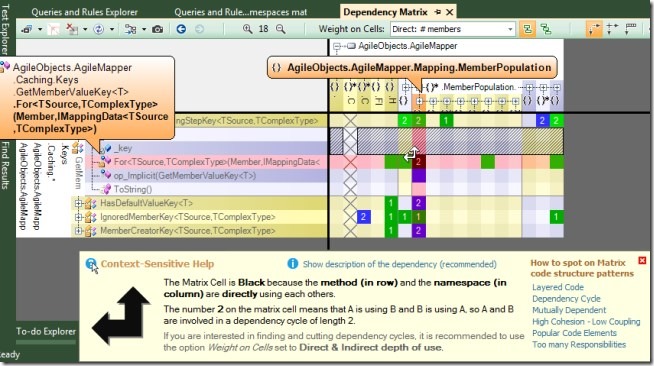This is the fourth in a series of blogs looking at things NDepend told me about a personal project of mine. The previous posts are:
- A description of the project (an object-object mapper) and the first change I made regarding an abstract class
- A look at various methods NDepend said were never called, and
- A curious case of Exception naming
This is the last of the Critical Rule violations NDepend warned me about in its first analysis. The detailed report looks like this:

It’s fairly self-explanatory - it lists which namespaces are mutually dependent, which namespaces they’re mutually dependent with, and how many Types are used by each pair of namespaces, creating the dependency. Mutually dependent namespaces indicate the way classes have been grouped doesn’t organise them in a strict higher-to-lower fashion, or perhaps that the way namespaces have been designated is inconsistent between parts of the system. Having mutually-dependent namespaces would make splitting my assembly into multiple assemblies awkward, if I wanted to do that sort of thing.
So I’ve got 24 namespaces which have mutual dependencies on other namespaces. Looking at the list,
you can see the first five involve the Helpers namespace, which is one I use for extension methods,
and the sixth one is Caching.Keys, which I use for classes which generate a unique key against
which to cache something. Following the instructions in the report above (export the first namespace
to the vertical header of the dependency matrix, with a few more steps after that) gives me a
dependency matrix, illustrating which classes are dependent on which:

The rows list the members of Caching.Keys, and the columns list the members of Mapping.MemberPopulation.
The blue squares indicate the number of members from the column using a member from the row, the
green squares indicate the number of members from the row using a member from the column, and the
black squares indicate members used mutually, with the number indicating the depth of the cycle. To
have all the dependencies going in the right direction, I should have no black squares, and all the
coloured squares the same colour - either green or blue.
Drilling into the members to which the black squares relate, you get more detail, along with a nice explanation in a pop-up help box:

So the problem is that the GetMemberValueKey.For() factory method is using members in the
MemberPopulation namespace, and members in the MemberPopulation namespace are using the
GetMemberValueKey.For() factory method. Which members? We can drill further still:

…and see exactly which ones - .For() is using (for example) the Member.QualifiedName property
(the green square with the arrow), and the TypedMember<T> type is using .For() (the blue square
in the right-most column).
So how can I fix it? I see two options:
- Have
TypedMember<T>pass the values the.For()method currently gets for itself into.For()as arguments. This would increase.For()’s parameter list from two to three, and would mean if I needed to add extra pieces of information to the key to ensure it’s unique, I’d have to add further arguments still. It would also be the opposite of the PreserveWholeObject refactoring pattern, which I tend to lean towards instead of having long lists of arguments. - Move the
GetMemberValueKeyType into the same namespace asTypedMember<T>. This would mean abandoning theCaching.Keysnamespace altogether, as I’m not going to move oneKeytype without moving the others, but I think this is my preferred approach.GetMemberValueKeyis only used byTypedMember<T>, and probably belongs in the same conceptual bucket - classes describing members on types which can be mapped from and to. I never was 100% comfortable with thatKeysnamespace, you know…
So that’s the last of the Critical Rules, next time I’ll start looking at the Non-critical ones, starting with an old classic - a constructor calling a virtual method. Or does it…?

Comments
0 comments